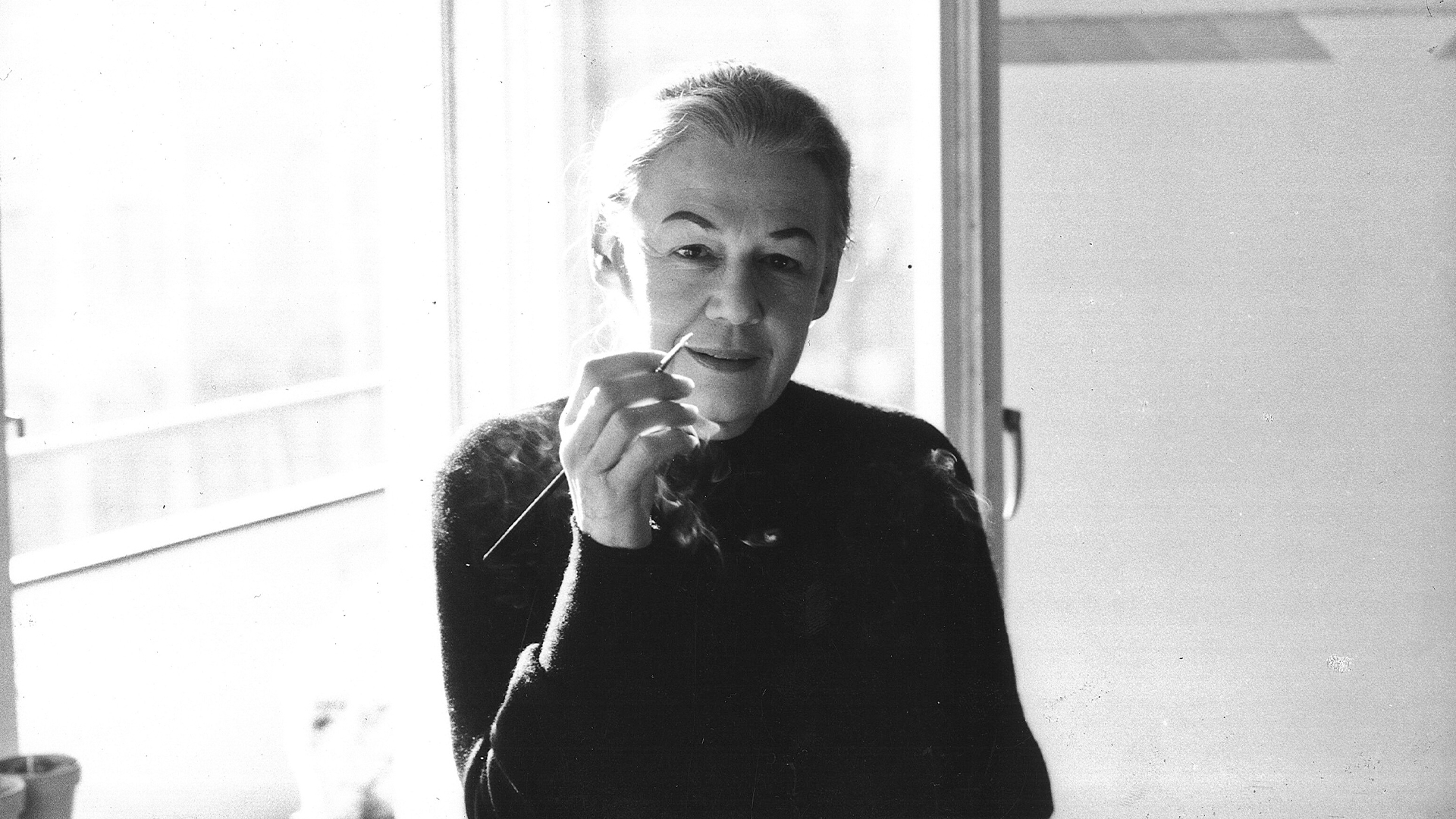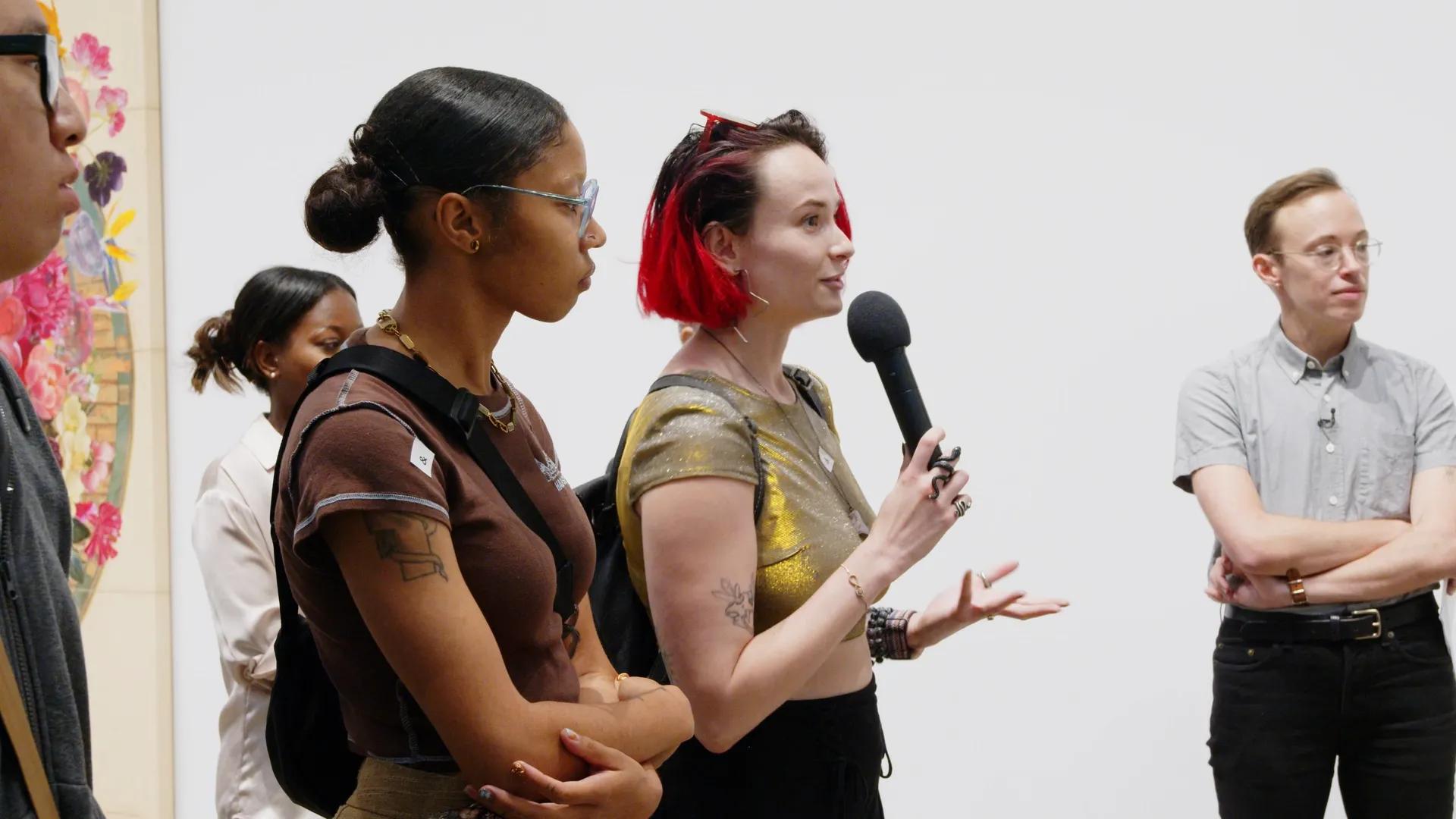Printmaking Glossary

Installation view, ‘Takesada Matsutani / Kate Van Houten. Paris Prints 1967-1978,’ 2024. Photo: Sarah Muehlbauer
Printmaking Glossary
‘There was a discipline in the thinking and the execution of things at the atelier . . . With printmaking, if you have a copper plate or a zinc plate and you’re working with the acid or burin, whatever your tool, it’s permanent. That’s it. You can’t go back.’—Kate Van Houten in ‘Life to Matter’
This printmaking glossary has been produced to accompany the exhibition ‘Takesada Matsutani / Kate Van Houten. Paris Prints 1967-1978’ at Hauser & Wirth, 18th Street from 25 January through 9 March 2024. A second iteration of the exhibition will be on view from 12 March through 20 April 2024. Learn more about the works on view by exploring the printmaking terms and techniques defined below.
Introduction to Printmaking Terms
Printmaking: an artistic process based on the principle of transferring images from a printing surface called a matrix onto another surface, such as paper or fabric. The resulting print is an original work of art, rather than a copy of a work in another medium.1
Matrix: a printing surface such as a woodblock, a linoleum block, a metal plate, a lithographic stone, or a mesh screen. Most, though not all, matrices are able to print the same image many times. 2
Edition: a series of identical impressions or prints made from the same matrix. Editions may be limited or unlimited in number. Each print in a limited edition is usually numbered in the lower left margin. For example, an edition of 50 would be numbered 1/50, 2/50,
etc. 3

Hector Saunier and Matsutani using the hot plate for inking intaglio plates at Atelier 17, 1968
Printmaking Techniques on View
Intaglio: the family of metal-plate printing techniques which transfers ink from the recesses of a matrix, rather than from the surface of a matrix. Intaglio comes from the Italian word intaglaire, which means “to incise.” Techniques using intaglio printing include etching, engraving, drypoint, aquatint and mezzotint. 4 Several different intaglio techniques might be used in the same print to achieve variations in contrast and tone. 5

Kate Van Houten, Corrections for directions on latitudes, 1968, Etching on BFK paper, 65 x 49.5 cm / 25 5/8 x 19 1/2 in © Kate Van Houten. Courtesy the artist and Hauser & Wirth. Photo: Thomas Barratt

La propagation-Y Jaune, Takesada Matsutani, 1967, Etching on BFK paper, 64.5 x 49.7 cm / 25 3/8 x 19 5/8 in © Takesada Matsutani. Photo: Sarah Muehlbauer
Etching: an intaglio printmaking technique in which lines or areas are incised into a metal plate using acid in order to hold ink. In etching, the plate can be made of iron, copper, or zinc. 6
To prepare the metal plate for etching, it is first polished to remove imperfections from the surface. The plate is then covered evenly with a layer of acid-resistant varnish or wax, which is called the ground. The artist then uses a fine-pointed tool called an etching needle to draw on the metal plate, scratching away parts of the ground and exposing the metal beneath. Once the design is complete, the plate is placed in acid. The ground protects the areas it still covers, while the drawn lines expose the plate and are incised, or “bitten,” by the acid.
After removing the coating, the plate is inked, filling only the incised lines. Damp paper is placed on the plate and run together through a press, forcing the paper into the incised lines to pick up the ink. The ink is thus transferred from the recesses of the plate to the paper.
Once printed onto paper, the etching's design appears in reverse of the original on the plate. The pressure of the press not only forces the ink onto the damp paper, but also produces an outline of the outer edges of the metal plate in the paper, known as a plate mark.

Takesada Matsutani, Le Radar, 1968, Burin and aquatint on BFK paper, 75.2 x 56 cm / 29 5/8 x 22 in © Takesada Matsutani. Photo: Sarah Muehlbauer

Takesada Matsutani, L' Angle, 1968, Burin and aquatint on BFK paper, 75.5 x 55.5 cm / 29 3/4 x 21 7/8 in © Takesada Matsutani. Photo: Sarah Muehlbauer
Engraving: an intaglio printmaking technique in which lines are incised into a bare metal plate using a burin, which is a tool with a sharp, V-shaped blade. When pressure is applied, the burin cuts away a thin layer of the metal to create a recessed line or groove in the plate. Different sizes of burins can affect the size of the lines; the pressure the printmaker applies to the burin can also be used to create thinner or thicker grooves in the plate.
The plate is wiped with ink, filling only the incised lines. Damp paper is placed on the plate and run together through a press, forcing the paper into the incised lines to pick up the ink. The ink is thus transferred from the recesses of the plate to the paper.
Once printed onto paper, the etching's design appears in reverse of the original on the plate. The pressure of the press not only forces the ink onto the damp paper, but also produces an outline of the outer edges of the metal plate in the paper, known as a plate mark.
Aquatint: an intaglio technique in which gradations of tone or shadow are produced rather than sharp lines; often this technique is used in conjunction with etching for images that can resemble watercolor or ink washes.
In this process the artist applies a layer of granular, acid-resistant material such as rosin to the plate before submerging it in an acid bath that "bites” in and around the layer, creating areas of texture. The use of varying granule sizes produces different degrees of tone. Usually, the more an area is eaten away, the more ink will transfer during printing, and the darker the tonal area will be.
For intaglio techniques, an artist might select paper based on its durability, pliability, smoothness and absorbency. Many of the works on view are printed on BFK cotton paper. ‘BFK’ refers to the initials of the original owners of the mill that produced the paper in the 19th century—Blanchet, Frères and Kiebler.
Viscosity: the viscosity printmaking method, also known as simultaneous color printing, was pioneered at Atelier 17 by artists Stanley William Hayter and Krishna Reddy. The process enables artists to produce multiple colors from a single plate.
Incorporating relief and intaglio printmaking techniques, the artist mixes inks at different viscosities. The term viscosity refers to the thickness of a liquid and describes the ink’s resistance to flow, which is controlled by the amount of oil the ink is mixed with—high-viscosity ink is stiff (thick, tacky, matte) with little oil added, while low viscosity ink is loose (runny, shiny) and contains a lot of oil. It is the ability of low-viscosity ink to resist ink with high viscosity that allows the colors to remain separate and not mix on the plate.
The plate is prepared and “bitten” at three levels—a deep intaglio level, a middle open-bite level and the plate surface. A different color is chosen for each level, with each color mixed to a different viscosity. The plate is inked and wiped with standard viscosity ink as an intaglio. Two rollers of different densities are then used to reach the various surface levels of the plate: a hard roller is used to ink the top level of the plate with the low-viscosity ink, and then a soft roller is used to ink the middle open-bite level with high-viscosity ink. The artist can then run the plate through the press just once to print the image, giving the artist the ability to produce multiple colors from a single plate. 7

Takesada Matsutani, 1908 une scène de Paris, 1977 Silkscreen on BFK paper, 21.4 x 26.4 cm / 8 3/8 x 10 3/8 in © Takesada Matsutani. Photo: Sarah Muehlbauer
Silkscreen or screenprint: a printmaking process where ink is forced through a mesh screen onto a surface. Making certain areas of the screen impervious to printing ink creates a stencil, which blocks the printing ink from passing through the screen. The ink that passes through forms the printed image. 8
Stencils can be composed of a wide variety of materials, including fabric, greasy paint or a design on a transparency. Stencils can be applied to the screen in different ways including placing them directly onto the surface of the screen, painting them onto the screen or by transferring a design onto the screen using a photo-sensitive emulsion. A squeegee is then used to press ink through the unblocked areas of the screen, directly onto paper. 9

Matsutani pulling the last color for the silkscreen work Sun Rise, 1971, at Van Houten’s studio in the 14th arrondissement
To continue exploring printmaking terms and techniques, visit these glossaries and resources pages:
1 Center for Book Arts, Printmaking Glossary
2, 4 Print Center New York, Printmaking Glossary
3 Museum of Modern Art, Art Terms
5 Black Women of Print, Printmaking Glossary
6, 8, 9 Metropolitan Museum of Art, What is Printmaking?
7 Folman, Liza. “Stanley William Hayter and Viscosity Printing”, Art in Print, Volume 2, Number 3
Resources
1 / 10









